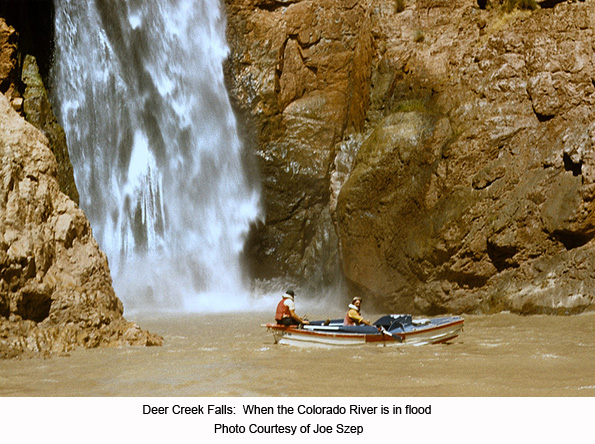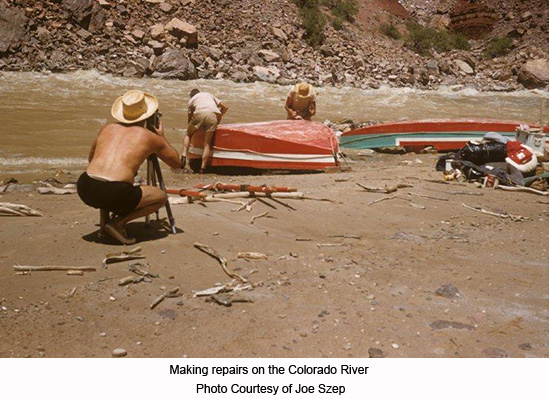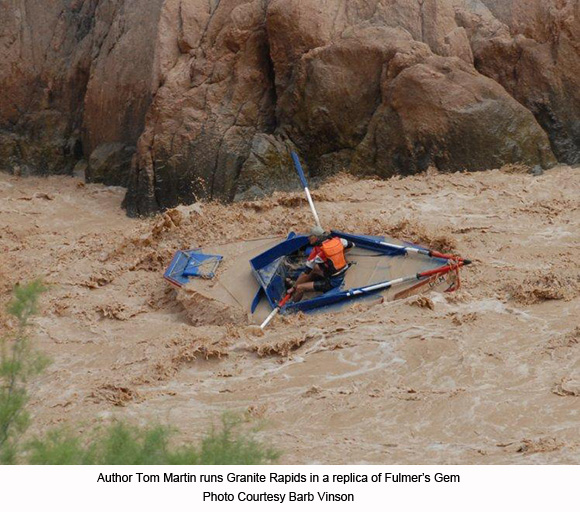 Big Water, Little Boats. By Tom Martin, Vishnu Temple Press, Flagstaff, AZ. ISBN 9780979505560
Big Water, Little Boats. By Tom Martin, Vishnu Temple Press, Flagstaff, AZ. ISBN 9780979505560
In this elegantly designed book, Tom Martin chronicles the adventures of the pioneers of wooden dories on the Colorado River through the Grand Canyon. Martin focuses on Moulty Fulmer and Fulmer's innovative wooden dory that he constructed named the Gem. It's also about other dory pioneers such as Brick Mortenson, P.T. Reilly, Dock Marston, and Martin Litton.
The river was truly wild then before the advent of the Glen Canyon Dam, and in one chapter, Martin tells the story of a 1957 trip when the Colorado was running at an amazing 126,000 cubic feet per second. (The average flow on the Colorado River these days is 15,000 cubic feet per second.)

His descriptions of 1950's river trips are a joy to read and revealing, in many ways, of the dynamics of egos and personalities when a group of people live closely together and face the challenges of a wilderness river.

Years ago before my first trip down the river in 1973 - which like many described in Martin's book was a do-it-yourself, non-commercial trip among friends - I had devoured the classic Sierra Club Book about the river: Time and the River Flowing. In the book were photos of a boatman by the name of PT Reilly, and ever since I'd always wondered about him and his experiences on the river. Finally, within the pages of Tom Martin's book, I found the answers.
As he does with Moulty Fulmer, Martin sketches for us Reilly's trajectory as novice to expert Colorado boatman. While clearly an excellent oarsman, Reilly had a bit of problem when it came to menu planning. His food choices on one 1953 trip included, among other items, Spam, chipped beef, Kool-Aid, peanut and jelly sandwiches, an interminable diet which drove trip participants to near rebellion.
On that same trip Martin describes how tensions boiled over between Reilly and another experienced boatman with the two goading and provoking one another from beginning to end.

Then there was another Reilly trip in 1956. On it was the dependable and good-natured Moulty Fulmer who rowed his Gem dory. Also rowing was Martin Litton who would become a leading environmentalist, staunchly opposing efforts to build dams on the Colorado River. Litton and another member of the party, a tough, young ex-Marine, quickly took a dislike to one another, the animosity escalating to the point where both "hated each other's guts" and a rock thrown by one nearly missed the other.
Of course, outward fights among party members are rare exceptions, and even the 1956 trip was described as Reilly as a "wonderful trip." It's hard not to come back from the Grand Canyon filled with a sense of accomplishment, awe and a deep appreciation for the river and the canyon - and any squabbling amongst the party sorts itself out.
There's more to Tom Martin's book, though, than history and stories of early boaters. He reminds us that these pioneers weren't paid professionals but men and women who were drawn to the river and its challenges. There are many people these days just like those pioneers who possess a similar can-do attitude and seek the same type of experience as the early river runners experienced. To the Park Service's discredit, they have instituted a lopsided permit system on the Grand Canyon which greatly favors commercial interests over the non-commercial public, and Martin has long advocated for a more equitable system.
What completes an already fine work is the story of Moulty Fulmer's boat, the Gem - and that's where the book begins. The boat had thought to have been lost when, on a high water trip, it and two other boats were abandoned and set loose down the river above a raging Lava Falls, the canyon's biggest rapid.
Years later it was found during a period of low water on Lake Mead jammed into a side gully. It was recovered and eventually ended up in a Park service garage on the South Rim. Then it was forgotten - until Tom Martin came upon its dusty remains and slowly began to unravel its story, told in the pages of his book.
As the book comes to a close, Martin re-constructs a replica of Fulmer's boat, and with it, attempts a run down the canyon. It turns out to be the perfect finishing touch to this fine, new historical text, certain to find a place among exceptional works about the pioneering river runners of the Grand Canyon.
Amazon.com: More Information or Purchase



